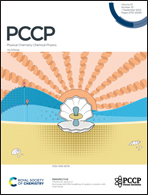A bistable cholesteric liquid crystal film stabilized by a liquid-crystalline epoxy/thiol compound-based polymer†
Abstract
Bistable cholesteric liquid crystals have promising application prospects in various fields, such as smart windows and displays. However, the long-term stability of two individual states is not easy to achieve, hindering their practical use. In this research, the bistable feature was enhanced by constructing a microsphere-type polymer with a liquid-crystalline epoxy/thiol monomer in negative dielectric anisotropic cholesteric liquid crystals. Spectroscopic and optical examinations revealed that either the transparent planar state or the opaque focal conic state can be maintained without the aid of an external field. Moreover, they can be switched to each other by applying a high- or low-frequency electric field. Further, factors such as the chemical structure of thiol compounds, curing temperature and curing time were investigated to explore their influences on the micro morphology of the polymer and thereby the electro-optical properties. In addition, the frequency-dependent driving scheme was analysed. Finally, bistable switching was demonstrated using an optimized sample. This energy-efficient bistable film shines light on future applications in smart windows, photonic paper and other electro-optical devices.



 Please wait while we load your content...
Please wait while we load your content...